Input interpretation

KCl potassium chloride + F_2 fluorine ⟶ Cl_2 chlorine + KF potassium fluoride
Balanced equation
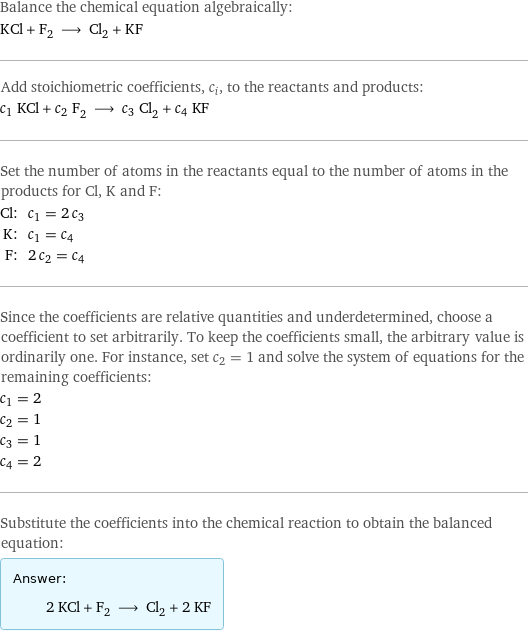
Balance the chemical equation algebraically: KCl + F_2 ⟶ Cl_2 + KF Add stoichiometric coefficients, c_i, to the reactants and products: c_1 KCl + c_2 F_2 ⟶ c_3 Cl_2 + c_4 KF Set the number of atoms in the reactants equal to the number of atoms in the products for Cl, K and F: Cl: | c_1 = 2 c_3 K: | c_1 = c_4 F: | 2 c_2 = c_4 Since the coefficients are relative quantities and underdetermined, choose a coefficient to set arbitrarily. To keep the coefficients small, the arbitrary value is ordinarily one. For instance, set c_2 = 1 and solve the system of equations for the remaining coefficients: c_1 = 2 c_2 = 1 c_3 = 1 c_4 = 2 Substitute the coefficients into the chemical reaction to obtain the balanced equation: Answer: | | 2 KCl + F_2 ⟶ Cl_2 + 2 KF
Structures

+ ⟶ +
Names

potassium chloride + fluorine ⟶ chlorine + potassium fluoride
Reaction thermodynamics
Enthalpy
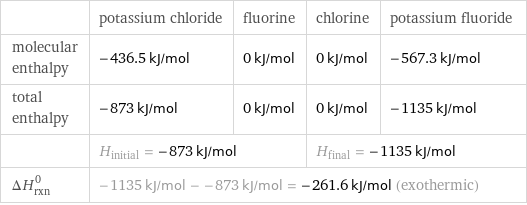
| potassium chloride | fluorine | chlorine | potassium fluoride molecular enthalpy | -436.5 kJ/mol | 0 kJ/mol | 0 kJ/mol | -567.3 kJ/mol total enthalpy | -873 kJ/mol | 0 kJ/mol | 0 kJ/mol | -1135 kJ/mol | H_initial = -873 kJ/mol | | H_final = -1135 kJ/mol | ΔH_rxn^0 | -1135 kJ/mol - -873 kJ/mol = -261.6 kJ/mol (exothermic) | | |
Gibbs free energy

| potassium chloride | fluorine | chlorine | potassium fluoride molecular free energy | -408.5 kJ/mol | 0 kJ/mol | 0 kJ/mol | -537.8 kJ/mol total free energy | -817 kJ/mol | 0 kJ/mol | 0 kJ/mol | -1076 kJ/mol | G_initial = -817 kJ/mol | | G_final = -1076 kJ/mol | ΔG_rxn^0 | -1076 kJ/mol - -817 kJ/mol = -258.6 kJ/mol (exergonic) | | |
Entropy
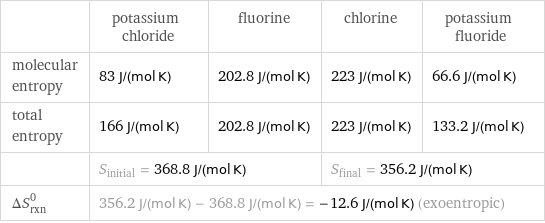
| potassium chloride | fluorine | chlorine | potassium fluoride molecular entropy | 83 J/(mol K) | 202.8 J/(mol K) | 223 J/(mol K) | 66.6 J/(mol K) total entropy | 166 J/(mol K) | 202.8 J/(mol K) | 223 J/(mol K) | 133.2 J/(mol K) | S_initial = 368.8 J/(mol K) | | S_final = 356.2 J/(mol K) | ΔS_rxn^0 | 356.2 J/(mol K) - 368.8 J/(mol K) = -12.6 J/(mol K) (exoentropic) | | |
Equilibrium constant
![Construct the equilibrium constant, K, expression for: KCl + F_2 ⟶ Cl_2 + KF Plan: • Balance the chemical equation. • Determine the stoichiometric numbers. • Assemble the activity expression for each chemical species. • Use the activity expressions to build the equilibrium constant expression. Write the balanced chemical equation: 2 KCl + F_2 ⟶ Cl_2 + 2 KF Assign stoichiometric numbers, ν_i, using the stoichiometric coefficients, c_i, from the balanced chemical equation in the following manner: ν_i = -c_i for reactants and ν_i = c_i for products: chemical species | c_i | ν_i KCl | 2 | -2 F_2 | 1 | -1 Cl_2 | 1 | 1 KF | 2 | 2 Assemble the activity expressions accounting for the state of matter and ν_i: chemical species | c_i | ν_i | activity expression KCl | 2 | -2 | ([KCl])^(-2) F_2 | 1 | -1 | ([F2])^(-1) Cl_2 | 1 | 1 | [Cl2] KF | 2 | 2 | ([KF])^2 The equilibrium constant symbol in the concentration basis is: K_c Mulitply the activity expressions to arrive at the K_c expression: Answer: | | K_c = ([KCl])^(-2) ([F2])^(-1) [Cl2] ([KF])^2 = ([Cl2] ([KF])^2)/(([KCl])^2 [F2])](../image_source/4d9ed26ca8d802fec79c71f6ed75f5f6.png)
Construct the equilibrium constant, K, expression for: KCl + F_2 ⟶ Cl_2 + KF Plan: • Balance the chemical equation. • Determine the stoichiometric numbers. • Assemble the activity expression for each chemical species. • Use the activity expressions to build the equilibrium constant expression. Write the balanced chemical equation: 2 KCl + F_2 ⟶ Cl_2 + 2 KF Assign stoichiometric numbers, ν_i, using the stoichiometric coefficients, c_i, from the balanced chemical equation in the following manner: ν_i = -c_i for reactants and ν_i = c_i for products: chemical species | c_i | ν_i KCl | 2 | -2 F_2 | 1 | -1 Cl_2 | 1 | 1 KF | 2 | 2 Assemble the activity expressions accounting for the state of matter and ν_i: chemical species | c_i | ν_i | activity expression KCl | 2 | -2 | ([KCl])^(-2) F_2 | 1 | -1 | ([F2])^(-1) Cl_2 | 1 | 1 | [Cl2] KF | 2 | 2 | ([KF])^2 The equilibrium constant symbol in the concentration basis is: K_c Mulitply the activity expressions to arrive at the K_c expression: Answer: | | K_c = ([KCl])^(-2) ([F2])^(-1) [Cl2] ([KF])^2 = ([Cl2] ([KF])^2)/(([KCl])^2 [F2])
Rate of reaction
![Construct the rate of reaction expression for: KCl + F_2 ⟶ Cl_2 + KF Plan: • Balance the chemical equation. • Determine the stoichiometric numbers. • Assemble the rate term for each chemical species. • Write the rate of reaction expression. Write the balanced chemical equation: 2 KCl + F_2 ⟶ Cl_2 + 2 KF Assign stoichiometric numbers, ν_i, using the stoichiometric coefficients, c_i, from the balanced chemical equation in the following manner: ν_i = -c_i for reactants and ν_i = c_i for products: chemical species | c_i | ν_i KCl | 2 | -2 F_2 | 1 | -1 Cl_2 | 1 | 1 KF | 2 | 2 The rate term for each chemical species, B_i, is 1/ν_i(Δ[B_i])/(Δt) where [B_i] is the amount concentration and t is time: chemical species | c_i | ν_i | rate term KCl | 2 | -2 | -1/2 (Δ[KCl])/(Δt) F_2 | 1 | -1 | -(Δ[F2])/(Δt) Cl_2 | 1 | 1 | (Δ[Cl2])/(Δt) KF | 2 | 2 | 1/2 (Δ[KF])/(Δt) (for infinitesimal rate of change, replace Δ with d) Set the rate terms equal to each other to arrive at the rate expression: Answer: | | rate = -1/2 (Δ[KCl])/(Δt) = -(Δ[F2])/(Δt) = (Δ[Cl2])/(Δt) = 1/2 (Δ[KF])/(Δt) (assuming constant volume and no accumulation of intermediates or side products)](../image_source/8034d47616e52d914e92cc51c8e9059b.png)
Construct the rate of reaction expression for: KCl + F_2 ⟶ Cl_2 + KF Plan: • Balance the chemical equation. • Determine the stoichiometric numbers. • Assemble the rate term for each chemical species. • Write the rate of reaction expression. Write the balanced chemical equation: 2 KCl + F_2 ⟶ Cl_2 + 2 KF Assign stoichiometric numbers, ν_i, using the stoichiometric coefficients, c_i, from the balanced chemical equation in the following manner: ν_i = -c_i for reactants and ν_i = c_i for products: chemical species | c_i | ν_i KCl | 2 | -2 F_2 | 1 | -1 Cl_2 | 1 | 1 KF | 2 | 2 The rate term for each chemical species, B_i, is 1/ν_i(Δ[B_i])/(Δt) where [B_i] is the amount concentration and t is time: chemical species | c_i | ν_i | rate term KCl | 2 | -2 | -1/2 (Δ[KCl])/(Δt) F_2 | 1 | -1 | -(Δ[F2])/(Δt) Cl_2 | 1 | 1 | (Δ[Cl2])/(Δt) KF | 2 | 2 | 1/2 (Δ[KF])/(Δt) (for infinitesimal rate of change, replace Δ with d) Set the rate terms equal to each other to arrive at the rate expression: Answer: | | rate = -1/2 (Δ[KCl])/(Δt) = -(Δ[F2])/(Δt) = (Δ[Cl2])/(Δt) = 1/2 (Δ[KF])/(Δt) (assuming constant volume and no accumulation of intermediates or side products)
Chemical names and formulas
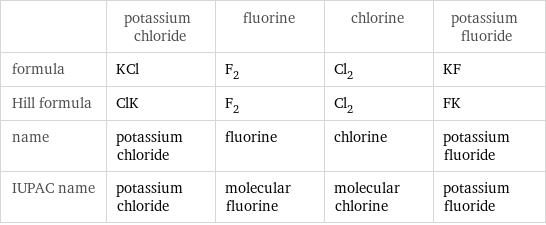
| potassium chloride | fluorine | chlorine | potassium fluoride formula | KCl | F_2 | Cl_2 | KF Hill formula | ClK | F_2 | Cl_2 | FK name | potassium chloride | fluorine | chlorine | potassium fluoride IUPAC name | potassium chloride | molecular fluorine | molecular chlorine | potassium fluoride
Substance properties
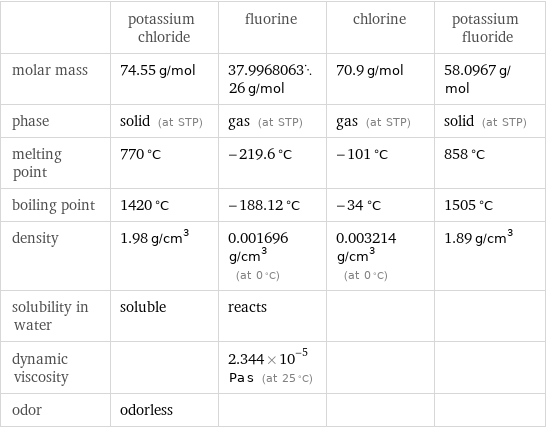
| potassium chloride | fluorine | chlorine | potassium fluoride molar mass | 74.55 g/mol | 37.996806326 g/mol | 70.9 g/mol | 58.0967 g/mol phase | solid (at STP) | gas (at STP) | gas (at STP) | solid (at STP) melting point | 770 °C | -219.6 °C | -101 °C | 858 °C boiling point | 1420 °C | -188.12 °C | -34 °C | 1505 °C density | 1.98 g/cm^3 | 0.001696 g/cm^3 (at 0 °C) | 0.003214 g/cm^3 (at 0 °C) | 1.89 g/cm^3 solubility in water | soluble | reacts | | dynamic viscosity | | 2.344×10^-5 Pa s (at 25 °C) | | odor | odorless | | |
Units
